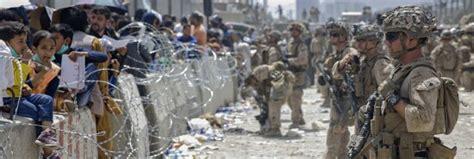
Taliban didn’t take chance to take out ISIS before suicide attack killed 13 US service members: Book
The Taliban failed to act on United States intelligence and conduct an assault on a building ISIS-K members were using as a staging post just days before a deadly terrorist attack killed 13 U.S. service members during the chaotic 2021 withdrawal of Afghanistan, a new book reveals.
With the U.S. military poised to leave Afghanistan at the end of the month, the Taliban quickly disposed of an Afghan army that had been too reliant on U.S. support and were able to overthrow the U.S.-backed government by August 15, 2021. The U.S. military subsequently began an evacuation operation out of Hamid Karzai International Airport in Kabul to bring out American citizens and the Afghan allies who worked with the military, while the Taliban provided an outer layer of security due to threats posed by terror groups.
Defense leaders argued at the time that while the Taliban wasn’t an ideal partner, they could be trusted in this particular instance because both sides had a similar goal: the U.S. military leaving the South Central Asian country as quickly as possible.
“They established a firm perimeter outside of the airfield to prevent people from coming on the airfield during our departure,” now-retired Gen. Frank McKenzie, the head of U.S. Central Command at the time, said on the day the last U.S. service members departed Afghanistan. “And we’ve worked that with them for a number of days. They did not have direct knowledge of our time of departure … But they were actually very helpful and useful to us as we closed down operations.”
Now, two years after the withdrawal, the U.S.’s relationship with the Taliban during the evacuation has drawn fresh scrutiny.
President Joe Biden cleared the U.S. military and intelligence officers to share threat assessments with the Taliban on August 18, just days after they overthrew the U.S.-backed government.
Intelligence officers had information indicating ISIS-K was preparing for an attack less than two miles from the airport. The U.S. “asked the [Taliban] to conduct an assault on the hotel, but they never did,” the declassified after-action review of the Afghanistan NEO from U.S. Central Command reveals.
The details of the Taliban’s inaction came to light recently with the release of the new book, “Kabul: The Untold Story of Biden’s Fiasco and the American Warriors Who Fought to the End.”
“I think that this was something that was a failure in Afghanistan for 20 years, a lack of understanding Afghanistan and understanding the Taliban because things are always more complicated than that,” Jerry Dunleavy, one of the authors of the book and a former reporter for the Washington Examiner, said in an interview. “So did the Taliban have an interest that aligned with us? Well, the Taliban wanted us to leave? Right. And, President Biden wanted to stick to the withdrawal date of August 31 and so, in that sense, you know, the Taliban wanted us out, we wanted to get out. And so we worked together, right? But in other ways, the Taliban’s interests very much do not align with those of the United States.”
The fraught relationship with the Taliban extends much further than just providing security at HKIA.
The U.S. military vacated its most important airfield in Afghanistan, Bagram air base, in early July 2021. The base also included the Parwan and Pul-e Charki prisons, which housed thousands of suspected terrorists of various groups. The Taliban ultimately gained control of the base during their offensive in early August, and they then released the prisoners indiscriminately, which included between 5,000-7,000 Taliban fighters, according to the after-action review.
One of the prisoners released by the Taliban was an ISIS-K fighter named Abdul Rahman al Logari, who had been arrested before carrying out a terror attack in India years earlier. They ultimately gave him to the CIA, which had tipped them off, and the CIA brought him to Parwan prison to serve his sentence.
Al Logari was the individual who detonated a suicide vest outside the gate of the Kabul airport on August 26, killing 13 U.S. service members and roughly 170 other Afghan civilians. The blast was the third deadliest incident in the U.S.’s two decades in Afghanistan.
“So simply by maintaining Bagram, we would have not just had a much safer, much more orderly evacuation, we would not have just been more successful at getting Americans and Afghan allies out, we wouldn’t have just been able to maybe stop the Taliban from taking Kabul, but the terrorists who killed 13 Americans on August 26 would have been in jail, would have just been stuck behind bars rather than being freed,” Dunleavy added.
Source » washingtonexaminer.com





